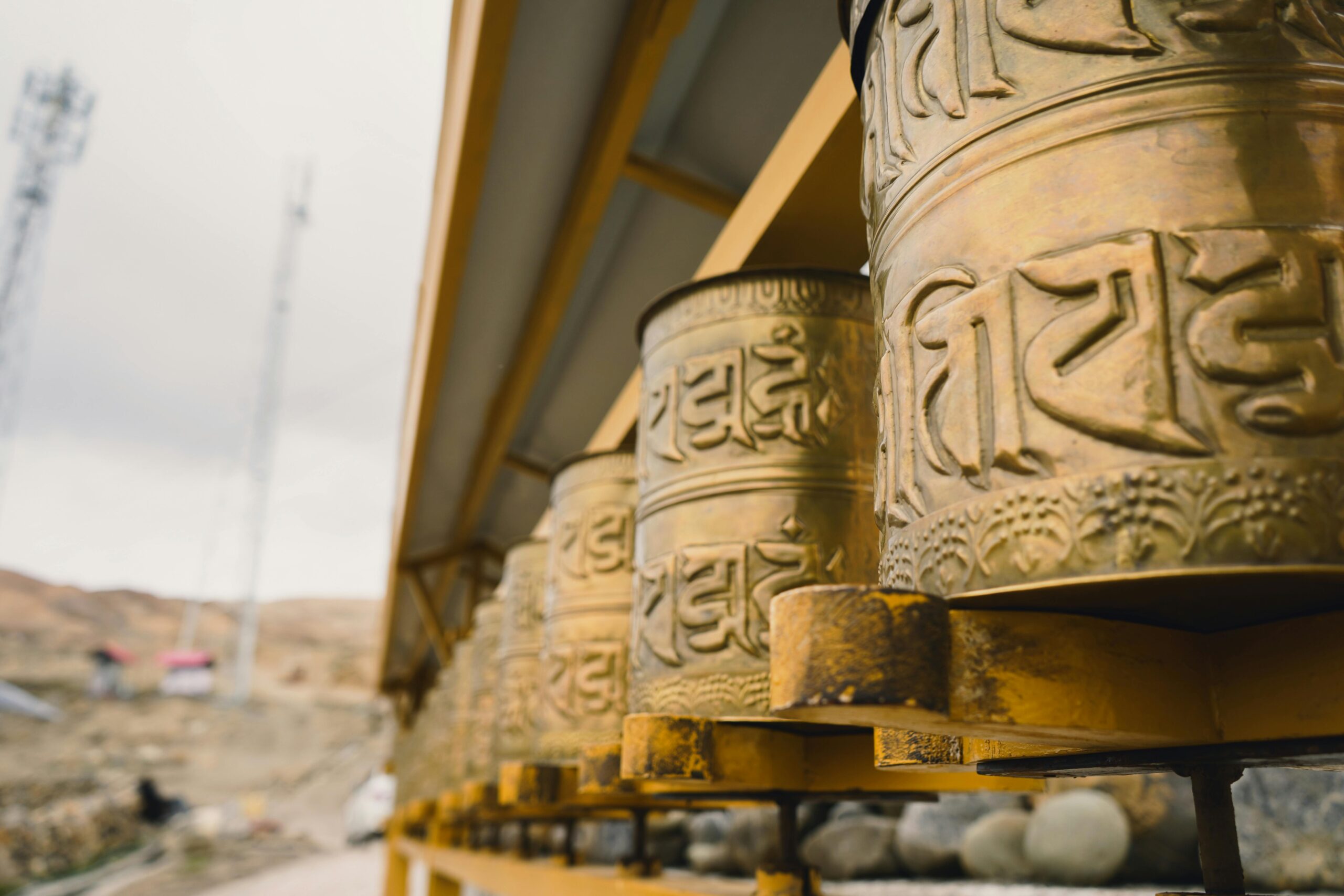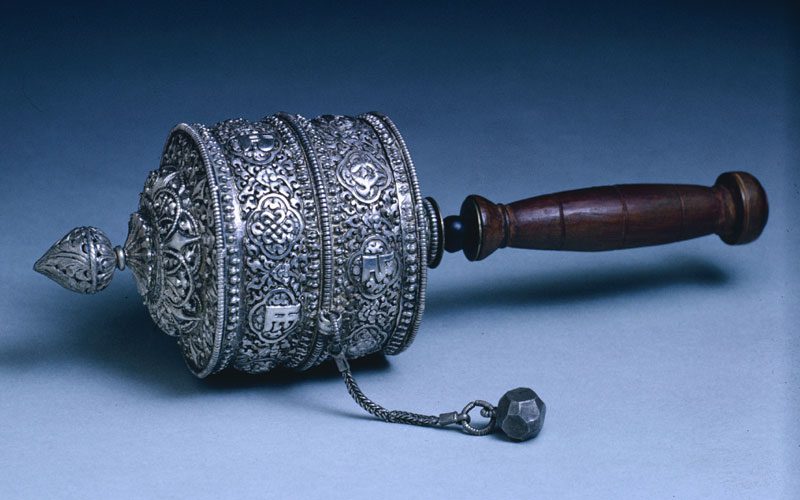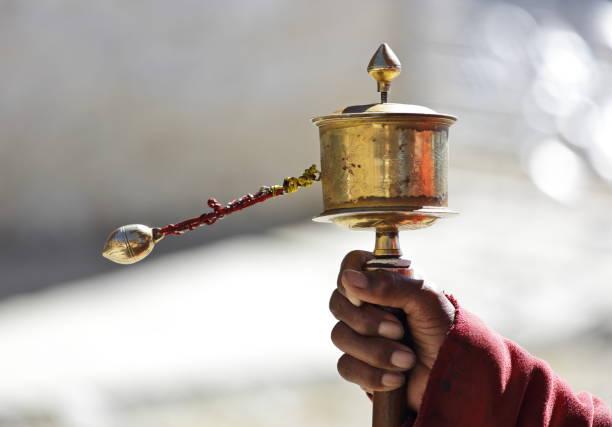The Buddhist Prayer Wheel: A Simple Path to Peace and Positivity

Have you ever seen a wheel gently spinning in a monastery or someone’s home and wondered what it means? That’s a Buddhist prayer wheel, a sacred symbol of peace, compassion, and spiritual awakening—deeply rooted in Tibetan Buddhism.
At Swodeshi.com, we bring this ancient wisdom into your daily life with handheld and table prayer wheels, crafted with care in Nepal. More than a spiritual artifact, the prayer wheel is a tool for mindfulness, healing, and energy—something our busy lives can truly benefit from.
Origin: From the Himalayas to Your Home
The prayer wheel originated in Tibet, where it became a key part of Vajrayana Buddhist practice. Inside each wheel are sacred mantras—most commonly “Om Mani Padme Hum”—written thousands or even millions of times. Instead of chanting them aloud, spinning the wheel is believed to release their blessings and merit into the world.
This way, even a layperson or someone unfamiliar with mantras can participate in spiritual practice meaningfully and powerfully.
Wisdom from the Himalayas: Body, Speech & Mind
As taught by a respected Tibetan Rinpoche, spinning a prayer wheel brings together:
- Virtue of the body: the physical act of spinning moves countless mantras.
- Virtue of speech: the power of inner mantras makes offerings to enlightened beings and purifies negativities.
- Virtue of the mind: the act focuses your attention, cultivating a calm and undistracted state.
“Even a single moment of spinning with a pure heart has vast benefit,” the Rinpoche reminds us.
When done with the intention to benefit all beings, you activate bodhichitta—the union of compassion and wisdom.
How to Use a Prayer Wheel (Step-by-Step)
Using a prayer wheel is simple but spiritually profound. Here’s how:
- (For Handheld Wheels) Hold the wheel in your right hand, keeping the cylinder upright.
- Spin clockwise, following the direction of the mantras.
- Focus your mind on compassion, healing, or peaceful thoughts.
- Optionally, chant or think “Om Mani Padme Hum” as you spin.
- Spin with grace and mindfulness—not quickly or carelessly.
This ritual becomes a moving meditation, a way to align your body, speech, and mind with positivity.
Types of Prayer Wheels
At Swodeshi.com, we offer two meaningful and functional types:
- Handheld Prayer Wheels: Ideal for personal use—small, light, and portable. Use it while walking, meditating, or anytime you need calm.
- Table Prayer Wheels: Designed for placement in your home, office, or sacred space. These can be gently spun throughout the day to maintain a flow of positive energy.
Other traditional types include:
- Large temple wheels in monasteries
- Water-powered or wind-powered wheels, found in nature
- Digital prayer wheels for modern seekers
But for daily life, handheld and table wheels are the most practical and accessible.
Where to Place a Prayer Wheel
- Handheld Prayer Wheel: Meant for your personal spiritual journey. Carry it in your bag, place it on your desk, or take it on a walk. Perfect for private practice anytime, anywhere.
- Table Prayer Wheel: Best placed in shared or calm spaces like:
- Your living room – radiates peace for your family and guests
- Office desk – brings clarity during stressful workdays
- Reception or lobby – creates a welcoming and blessed environment
Every spin becomes a quiet blessing—not just for you, but for everyone around you.
Prayer Wheel in Real Life: Simple Moments, Deep Impact
Here are a few real-life ways to integrate a prayer wheel into your daily routine:
- Feeling overwhelmed at work? A short pause to spin the table wheel can restore calm and focus. It gently shifts the energy of your space and even lifts the mood of those nearby.
- At home, it can be a centerpiece that invites peace and reflection—benefiting family members and even guests.
- During meditation or prayer, it helps deepen your concentration and intention.
- Many also spin it silently before starting a project or making a decision, using it as a tool for clarity and guidance.
Scientific and Emotional Benefits
Modern science shows that repetitive actions—like spinning a wheel—have similar effects to meditation:
- Reduces stress and anxiety
- Enhances focus and mindfulness
- Encourages a calmer, more compassionate mindset
You don’t need to be a monk to feel its impact. Just spin with intention, and let the movement become a moment of peace.
Lessons from the Buddhist Prayer Wheel
- Small actions matter: Repetition builds inner strength.
- Move with purpose: Your intention shapes your reality.
- Let go: Like the spinning wheel, life keeps turning.
- Act for others: The most meaningful practice is the one that benefits all.
Final Thought: A Spin Toward Harmony
The prayer wheel may be ancient, but its message is timeless. Whether you choose a handheld wheel for personal use or a table wheel for your home or office, each spin becomes a symbol of hope, healing, and compassion.
At Swodeshi.com, we honor this tradition with carefully crafted prayer wheels made in Nepal, so you can bring this sacred practice into your everyday life.
FAQ on Buddhist Prayer Wheel
1. What is the Buddhist prayer wheel used for?
A Buddhist prayer wheel is used to accumulate wisdom, merit, and purify negativities. It contains scrolls printed with sacred mantras, often “Om Mani Padme Hum.” Spinning the wheel is believed to have the same spiritual benefit as reciting the prayers aloud.
2. Which direction to spin prayer wheel?
The Buddhist prayer wheel should be spun clockwise, following the direction of the sun. This aligns with the mantra’s written orientation and respects traditional Buddhist practice.
3. Can anyone use a prayer wheel?
Yes, anyone can use a Buddhist prayer wheel, regardless of religion or background. It is a spiritual tool meant to promote inner peace, mindfulness, and positive energy for all beings.
4. What is the 12 wheel of Buddha?
The 12 wheels of Buddha, also known as the Twelve Links of Dependent Origination, explain the cycle of birth, suffering, death, and rebirth in Buddhism. They represent how ignorance leads to suffering and how one can break free from this cycle through awareness.
5. What is the prayer wheel in Nepal?
In Nepal, prayer wheels (Mani wheels) are commonly found in Buddhist stupas, monasteries, and mountain trails. They are an integral part of Tibetan Buddhist culture and are used by both monks and laypeople to earn spiritual merit.
6. What does a wheel symbolize in Buddhism?
In Buddhism, the wheel (Dharmachakra) symbolizes the Noble Eightfold Path, the teachings of Buddha, and the cycle of life and rebirth (samsara). The turning of the wheel represents the spreading of Buddha’s wisdom across the world.







